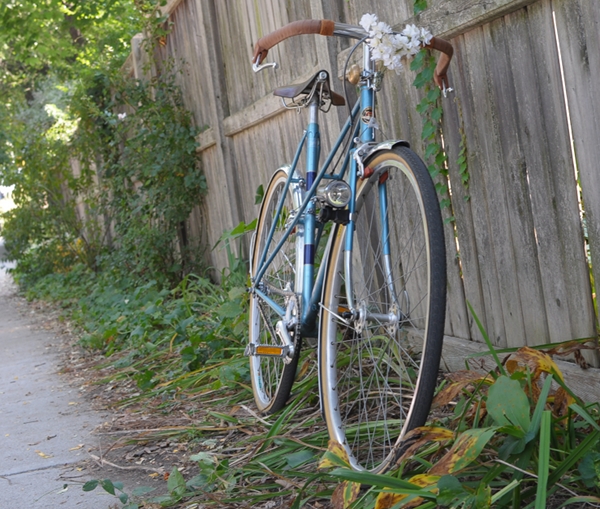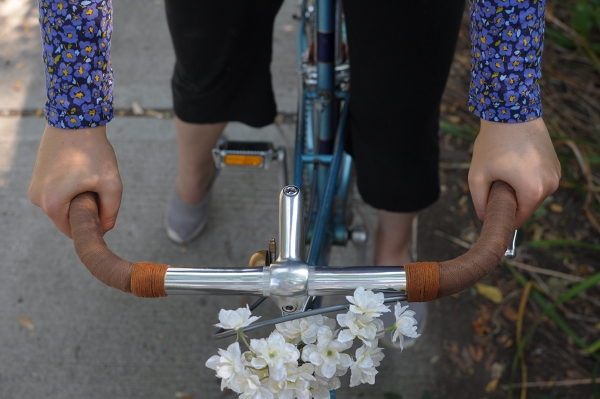With the Renaissance of the Mixte still going strong this year, I find myself in frequent discussions over its benefits and drawbacks. And inevitably, I catch myself over-stressing the drawbacks - but it's only because I want to make sure that those who dream of mixtes look at them realistically and not through rose-coloured glasses. There's this idea that the mixte is the perfect do-everything bike, because it can be used both as a roadbike and as a city bike - but I do not entirely agree. So here are some "myths" about the mixte, which I would like to supplement with a more realistic set of expectations:
1. The mixte is a roadbike and a transportation bike in one
In theory yes, in practice not really. The typical mixte frame has roadbike geometry, combined with a lower step-over height than a diamond frame bike. The road geometry is what makes it light, fast, and suitable for being set up as a roadbike. The lower stepover is what makes mounting and dismounting easier, thus making it suitable for transportation.
But while the mixte frame design may work as a roadbike or a transportation bike, you can't actually set it up as both simultaneously. If you set up your mixte with upright handlebars, it will be faster than a heavy, upright city bike, but it will not perform like a roadbike with drop bars. On the other hand, if you set it up with drop bars it may perform like a roadbike, but the positioning will be too aggressive for a city bike. The mixte frame construction has the potential to be either, but you still have to choose.
2. The mixte is easy to mount and dismount
That depends on where you are coming from. If you are used to diamond frame bicycles, then yes it is easier: On a mixte, you don't need to swing your leg around the back, but can lean the bike toward you and step over. However, if you are used to step-through and loop frame bicycles, the mixte may disappoint you. On step-through and loop frames, the top tube is low enough to just freely walk through. The mixte's stepover is considerably higher and requires leaning the bike toward you, then bending your leg at the knee in order to get your foot over. The construction also does not allow you to hop off the bike sideways as you're coming to a stop, as some get accustomed to doing on a step-through.
For comparison: The standover height on my Gazelle loop frame is 18.5", whereas the standover height on my Royal H. mixte is 24" - a substantial difference. Some find the mixte standover to be too high for the easy on-off they seek in a transportation bike.
3. The Mixte is Comfortable
Don't count on it. I've discussed this in an earlier post about buying a vintage mixte, but I still get lots of "I got this nice townie bike, but it's so uncomfortable!" emails, so I wanted to bring it up again. Mixte bicycles look cute and so we tend to assume they are easy to ride. But most of them are essentially roadbikes with upright handlebars, and road geometry does not make for the most relaxed and comfortable ride. Roadbike geometry also presents logistical problems, such as short chainstays making it more difficult to carry panniers, and toe overlap making tight turns trickier.
It is not impossible to find a comfortable mixte. If you're buying vintage, look for one that is a touring and not a road model, and is made of cro-moly steel. If you're buying new, I know that the Rivendell Betty Foy is a comfortable bike, and I've heard good things about the Soma Buena Vista's ride quality as well. And then of course there is the custom route, where the framebuilder can ensure that comfort is a priority. But there is nothing about the mixte design that is inherently comfortable; you will need to put some time into research and test rides.
I hope that all of this does not come across as overly negative. Having gotten one custom made, I am obviously a fan of mixtes. But I do think that it helps to have a realistic understanding of what sort of bicycle a mixte is - which includes not only knowing its benefits, but also its limitations. If you are a mixte owner, what make and model do you ride? how have you set it up? do you use it for transportation or recreationally? and what benefits and drawbacks would you say it has?









0 comments:
Post a Comment